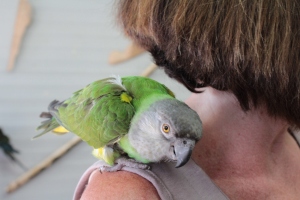Last week I spoke about punishment as a training aid, and denounced the way some people say you should never punish when training.
But it’s very important to recognise that punishment is very dangerous and should be used sparingly.
I really wanted to put this in the last week’s post, but it was getting long enough. So I saved the rest in a draft which WordPress promptly went and lost. Harrumph. It’s difficult enough writing blog posts with Little Miss Princess Paws wanting constant dominion over my hands. (We are still at war over whether the laptop keyboard is a suitable place to sit).
I had written a post about dog aggression and how punishment can be dangerous when used to treat dog aggression, but now I’m faced afresh with a blank page, I think we’ll take a different tact.
Last week we talked about some of the punishments I’ve used for Athena, namely the chilli powder on the cables as positive punishment to stop her from chewing on the wires. I mentioned that the positive punishment wasn’t perceived as coming from me.
This is what I want to talk about today – the effect positive punishment has on the human-animal bond. Positive punishment is aversive, that is to say it presents the animal with a stimulus that it finds unpleasant. If the source of that stimulus is its owner, it can start to associate its owner with the unpleasant stimulus.
Inappropriate dog behaviours such as aggression to people, aggression to dogs, excessive fear and excessive excitement have been significantly associated with owners who use punishment to train their dogs (Hiby et al, 2004). Now this is a survey of owners and doesn’t distinguish between positive and negative punishment in its results. It is by no means saying that punishment causes these behavioural problems in dogs, but that owners who use mainly punishment to train their dogs report more behavioural problems. I find it particularly interesting that separation anxiety was linked with the frequency of punishment-based training methods.
Another survey of dog owners (Herron et al, 2009) asked the owners what kind of punishment they used when trying to modify the dog’s behaviour. The kinds of positive punishment used were:
- Striking or kicking the dog
- ‘Growl’ at the dog
- Force the dog to release something from its mouth
- The godawful ‘alpha roll’ (adjective mine)
- Stare dog down
- ‘Dominance down’
- The ‘grab and shake’ dog.
Now depending on how you do it ‘growl’ at dog and ‘stare dog down’ are not much different than how I signal to an animal that I’m unhappy. Just like I would a child, when an animal is doing something I’m unhappy about my body language changes, I focus on them, and my expression becomes ‘arch’ or angry. This is simply human body language and works remarkably well with both pre-verbal children and animals. It’s held for a very short period and is followed by verbal cues that the individual’s in trouble if it’s not immediately heeded. (Though note it’s not immediately clear how these were defined in the survey or by the respondents).
Some of these other punishments, such as the ‘alpha roll’, have been taken down before. I was first introduced to this technique via the BBC show Dog Borstal and trainer Mic Martin. He used it sparingly, but I remember thinking at the time the show was quick to glamorise and sensationalise the technique. And I don’t think on this blog I need to go into the whole ‘dominance training techniques’ any more.
But the point is that at least 25% of the dogs which received these punishments then went on to show aggression to their owners.
Positive punishment, particularly those which involve you threatening an animal, or posing an animal a threat, present a challenge to the animal. It needs to have the cognitive ability to figure out how to remove that challenge. The idea behind positive punishment is that the challenge will be removed when you stop showing the behaviour you’re showing, but if you threaten too much, you may well provoke another behaviour in response. After all, what human relationship would remain cordial if you started to behave aggressively? After all, much of these positive punishment methods, particularly those detailed in Herron et al, are definitely aggressive.
Used inappropriately, punishment is ineffective, if not downright dangerous. The punishment should be something the animal can control (i.e. Athena can control whether or not to eat the chilli coated wire) and it should not make the animal face some kind of conflict.
In some ways this kind of punishment is a self-fulfilling prophesy. Most normal people don’t go straight to the ‘alpha roll’ for things like stealing a biscuit or chewing on the furniture. A simple ‘no’ or a diversion is usually used. But these more extreme punishments seem more suitable for more dangerous behaviour, things like aggression or serious destruction. But what is it that’s causing these behaviours? Aggression usually comes from an animal feeling challenged by its environment. Aggression is, after all, a tool used for the animal to get its way. Some animals go for that tool more often than others.
When you present this kind of animal with another challenge (from a place where it should feel safe and secure, no less), is it any wonder it uses its favourite tool to try and respond to that challenge?
So yes, positive punishment works when it’s used appropriately, but the inappropriate uses of positive punishment are rife. My handy guide for the non professional?
- Make sure the animal has choice in experiencing the positive punishment.
- Make sure the positive punishment isn’t exacerbating the problem (don’t fight aggression with aggression).
- Never use positive punishment on its own.
- Make sure that the positive punishment is IMMEDIATELY removed the moment the animal ceases the undesired behaviour.
Punishment can work, but only when used properly.
